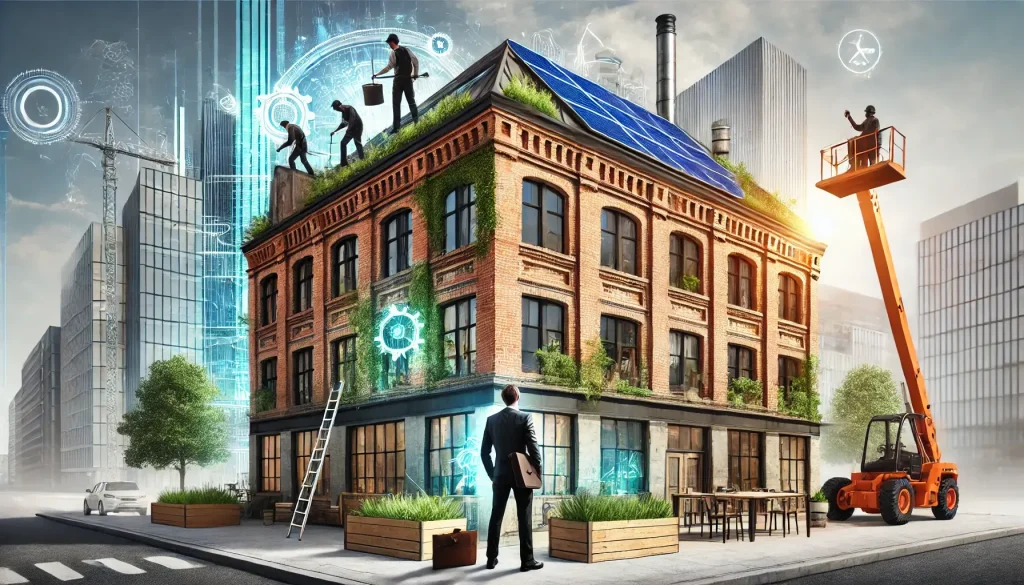Nel mondo di oggi, dove sostenibilità e patrimonio convergono, stiamo ripensando il futuro delle strutture storiche. L'invito a riaccendere vecchi edifici sta trasformando i paesaggi urbani e rivitalizzando le comunità. Noi di Eu Setor sosteniamo strategie innovative che fondono le moderne pratiche ecologiche con il fascino senza tempo dell'architettura storica, assicurando che i vecchi edifici rinascano come punti di riferimento sostenibili.

Indice
L'importanza di riaccendere le strutture storiche
Il recupero di vecchi edifici va oltre la conservazione: si tratta di trasformare queste strutture in spazi funzionali e responsabili dal punto di vista ambientale. Scegliendo di riaccendere architettura del patrimonio, noi:
- Ridurre i rifiuti urbani: La ristrutturazione e il riuso adattativo riducono i rifiuti da demolizione e minimizzano l'impatto ambientale.
- Preservare l'identità culturale: Il restauro degli edifici storici salvaguarda il nostro patrimonio culturale, integrando al contempo soluzioni moderne e sostenibili.
- Promuovere l'efficienza energetica: L'ammodernamento di vecchie strutture con tecnologie eco-compatibili porta a un risparmio energetico e a una riduzione delle emissioni di carbonio.
Principi chiave per riaccendere gli edifici antichi
Il successo della rivitalizzazione degli edifici storici richiede un'attenta combinazione di conservazione e innovazione. Ecco i principi fondamentali che guidano il nostro approccio a riaccendere vecchie strutture:
Restauro sostenibile
Le moderne pratiche sostenibili sono al centro di qualsiasi progetto di rilancio. Incorporando tecnologie di bioedilizia e sistemi ad alta efficienza energetica, noi riaccendere vecchi edifici per soddisfare gli standard ambientali odierni, pur rispettando il loro design originale.
- Materiali ecologici: L'utilizzo di materiali riciclati, di recupero e a basso impatto conserva il carattere dell'edificio e riduce l'impatto ambientale.
- Aggiornamenti energetici: L'installazione di sistemi HVAC ad alta efficienza energetica, di illuminazione a LED e di fonti di energia rinnovabile aiuta a modernizzare le vecchie strutture e a ridurre il consumo energetico.
Riuso adattativo
Il riuso adattivo trasforma edifici obsoleti in spazi vivaci che rispondono alle esigenze contemporanee. Questo approccio riaccendere vecchie strutture comporta la reimmaginazione della loro funzione senza sacrificare l'integrità architettonica.
- Spazi multifunzionali: La conversione di edifici storici in sviluppi a uso misto, come loft residenziali, centri comunitari o spazi di lavoro creativi, ne garantisce la sostenibilità a lungo termine.
- Design flessibile: L'enfasi sul design modulare e sui layout adattabili consente alle strutture ristrutturate di evolvere in base alle mutevoli esigenze della comunità.
Conservazione del patrimonio
Se la modernizzazione è essenziale, la conservazione del carattere autentico degli edifici storici è altrettanto importante. Nella nostra missione di riaccendere Per questo motivo, per la realizzazione di strutture antiche, fondiamo le nuove tecnologie con pratiche di restauro meticolose che onorano la maestria originale.
- Tecniche di restauro: I metodi tradizionali, come la riparazione della muratura, la conservazione del legno e i dettagli adeguati all'epoca, mantengono l'integrità storica dell'edificio.
- Integrazione culturale: Il coinvolgimento di storici locali, architetti e membri della comunità assicura che l'edificio restaurato rifletta il suo significato storico e il suo contesto culturale.
Passi per riaccendere i vecchi edifici
L'avvio di un progetto di rinascita sostenibile comporta una serie di fasi attentamente pianificate. Di seguito una guida completa per riaccendere vecchi edifici e trasformarli in spazi moderni ed ecologici.
Fase 1: Valutazione completa
Il primo passo consiste nel valutare le condizioni attuali dell'edificio e il suo potenziale per una rinascita sostenibile.
- Analisi strutturale: Eseguire ispezioni approfondite per determinare l'integrità delle fondamenta, del tetto e degli elementi portanti.
- Ricerca storica: Documentare la storia dell'edificio, il progetto originale e le caratteristiche architettoniche significative che devono essere conservate.
- Audit energetico: Valutare l'attuale utilizzo dell'energia e identificare le aree in cui le moderne tecnologie possono migliorare l'efficienza.
Fase 2: Sviluppo di un piano di rivitalizzazione sostenibile
Dopo aver compreso chiaramente le condizioni dell'edificio, create un piano dettagliato che delinei sia la conservazione che gli aggiornamenti moderni.
- Definire gli obiettivi: Stabilire obiettivi chiari per il progetto, tra cui obiettivi di efficienza energetica, miglioramenti funzionali e miglioramenti estetici.
- Budget e tempistica: Assegnare le risorse e stabilire tempi realistici per ogni fase del restauro. Assicurarsi che le pratiche sostenibili rimangano una priorità durante tutto il processo.
- Pianificazione collaborativa: Collaborare con architetti, ingegneri ed esperti di sostenibilità per integrare soluzioni progettuali innovative che soddisfino sia gli standard storici che quelli moderni.
Fase 3: Implementazione di aggiornamenti ecocompatibili
La fase di esecuzione prevede un'attenta integrazione dei sistemi moderni nel quadro storico.
- Selezione del materiale: Utilizzate materiali eco-compatibili e metodi di riciclaggio per sostituire i componenti obsoleti preservando le caratteristiche originali.
- Integrazione tecnologica: Installate sistemi ad alta efficienza energetica come termostati intelligenti, pannelli solari e isolamento ad alte prestazioni per ridurre drasticamente il consumo energetico.
- Modifiche di riuso adattativo: Riconfigurare gli spazi interni per servire meglio le funzioni contemporanee, creando ambienti versatili che supportino l'uso della comunità e la redditività commerciale.
Fase 4: conservazione e restauro
Pur modernizzando, è fondamentale preservare il carattere storico che rende unico l'edificio.
- Artigianato: Utilizzare tecniche di restauro tradizionali per riparare e conservare i dettagli architettonici originali.
- Accenti culturali: Incorporare elementi di design che celebrino l'eredità dell'edificio, come l'illuminazione d'epoca, le modanature decorative e le facciate restaurate.
- Finiture ambientali: Applicare sigillanti sostenibili e rivestimenti ecocompatibili per proteggere sia la struttura che le nuove funzioni moderne integrate.
Fase 5: Integrazione finale e coinvolgimento della comunità
La fase finale consiste nell'integrare l'edificio rivitalizzato nel tessuto urbano e nel garantirne la sostenibilità continua.
- Posizionamento strategico: Reintrodurre l'edificio nella comunità con un design che si integri con il paesaggio urbano circostante.
- Programmazione funzionale: Sviluppare piani per l'utilizzo dell'edificio, assicurandosi che soddisfi le esigenze dei residenti e delle imprese locali.
- Manutenzione continua: Stabilire pratiche di manutenzione sostenibili per garantire che le prestazioni e il patrimonio dell'edificio siano preservati nel tempo.
- Attività di sensibilizzazione della comunità: Coinvolgere il pubblico con visite, workshop o eventi che mostrino il successo dell'integrazione tra conservazione storica e sostenibilità moderna.
Tendenze innovative che plasmano il futuro della riqualificazione degli edifici
Il campo della rinascita dell'edilizia sostenibile è in rapida evoluzione, con tendenze entusiasmanti che stanno definendo nuovi parametri di riferimento per il restauro eco-compatibile.
Strumenti digitali e restauro basato sui dati
- BIM (Building Information Modeling): La modellazione digitale consente una pianificazione e una visualizzazione precise, assicurando che i progetti di restauro siano eseguiti con la massima efficienza e il minimo spreco.
- Sensori intelligenti: I sensori incorporati monitorano le prestazioni dell'edificio in tempo reale, consentendo una manutenzione e una gestione energetica proattive.
Integrazione delle tecnologie verdi
- Sistemi di energia rinnovabile: I sistemi solari, eolici e geotermici sono sempre più integrati nelle strutture storiche, riducendo in modo significativo la loro impronta di carbonio.
- Tetti e pareti verdi: L'integrazione della vegetazione negli esterni degli edifici non solo migliora l'isolamento, ma contribuisce anche alla biodiversità urbana e alla qualità dell'aria.
Progetti di rivitalizzazione su iniziativa della comunità
- Rinnovamento urbano collaborativo: Le amministrazioni locali e le organizzazioni comunitarie collaborano con le imprese private per creare progetti di rinnovamento urbano sostenibili che riutilizzano gli edifici storici a beneficio della collettività.
- Iniziative di conservazione culturale: I programmi che si concentrano sulla conservazione del patrimonio culturale e sulla promozione della sostenibilità stanno prendendo piede, garantendo una coesistenza armoniosa tra storia e modernità.
Conclusione: Abbracciare il potere di riaccendere
Il viaggio verso riaccendere Il recupero di vecchi edifici è un'audace testimonianza del nostro impegno per la sostenibilità, l'innovazione e la conservazione culturale. Reimmaginando le strutture recuperate con tecniche moderne ed eco-compatibili, non solo diamo nuova vita agli spazi storici, ma creiamo anche ambienti vivaci e funzionali al servizio delle generazioni future.
Noi di Eu Setor ci occupiamo con passione della trasformazione di vecchi edifici in punti di riferimento sostenibili che onorano il passato e abbracciano il futuro. Vi invitiamo a unirvi a noi in questo viaggio di trasformazione, a esplorare strategie di restauro innovative e a contribuire a un'eredità di responsabilità ambientale e design senza tempo.
Per ulteriori approfondimenti, guide ai progetti e ispirazioni sulla rinascita dell'edilizia sostenibile, visitate il nostro sito web all'indirizzo eu.setorreciclagem.com.br e diventare parte della comunità Eu Setor. Lasciateci riaccendere i nostri paesaggi urbani, rivitalizzare il nostro patrimonio e costruire un futuro in cui sostenibilità e storia camminino di pari passo.
